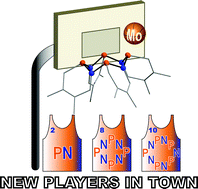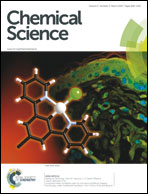Diatomic PN – trapped in a cyclo-tetraphosphazene†
Abstract
(Me3Si)2NPCl2, which is formally capable of eliminating two equivalents of Me3SiCl, is shown to be a suitable starting material to prepare highly reactive PN species by successive elimination of Me3SiCl. Me3SiCl elimination can be triggered either thermally and/or by addition of a Lewis acid such as GaCl3, thus leading to the formation of a highly labile aminochlorophosphenium cation in [(Me3Si)2NPCl][GaCl4] and iminophosphenium salt [Me3Si–N![[triple bond, length as m-dash]](https://www.rsc.org/images/entities/char_e002.gif) P][GaCl4] upon warming to ambient temperatures. This work describes the synthesis and characterization of a cyclo-tetraphosphazane in [PN(dmb)]4 (5) (dmb = 2,3-dimethyl-1,3-butadiene) obtained by thermal elimination of Me3SiCl from (Me3Si)2NPCl2 at 120 °C in toluene solution. The reactive intermediate Me3SiN
P][GaCl4] upon warming to ambient temperatures. This work describes the synthesis and characterization of a cyclo-tetraphosphazane in [PN(dmb)]4 (5) (dmb = 2,3-dimethyl-1,3-butadiene) obtained by thermal elimination of Me3SiCl from (Me3Si)2NPCl2 at 120 °C in toluene solution. The reactive intermediate Me3SiN![[double bond, length as m-dash]](https://www.rsc.org/images/entities/char_e001.gif) PCl was trapped with dmb to form the cyclic phosphazane Me3SiN(dmb)PCl, which eventually oligomerizes to give 5. In the presence of dmb or chd (chd = 1,3-cyclohexadiene) (Me3Si)2NP(OTf)2 reacts by eliminating Me3SiOTf to yield the spirocyclic phospholenium salts [Me3SiN(dmb)P(dmb)][OTf] (7) and [Me3SiN(chd)P(chd)][OTf] (8), of which the solid state structures were successfully determined. 7 decomposes when exposed to moisture to give an unprecedented cyclic ammonium phosphinoxide [P(O)H(dmb)2NH2][OTf] (9). Tetraphosphazane 5 is shown to be a versatile ligand in transition metal chemistry. It coordinates in an η3-fashion in {[PN(dmb)]4Mo(CO)3} (5·Mo) and is able to coordinate a second metal fragment, exemplified by the formation of the ditungsten complex{[PN(dmb)]4W2(CO)7} (5·W2) with a semi-bridging carbonyl ligand. All compounds were structurally characterized and the bonding situation was investigated by density functional theory and natural bond orbital analysis (NBO).
PCl was trapped with dmb to form the cyclic phosphazane Me3SiN(dmb)PCl, which eventually oligomerizes to give 5. In the presence of dmb or chd (chd = 1,3-cyclohexadiene) (Me3Si)2NP(OTf)2 reacts by eliminating Me3SiOTf to yield the spirocyclic phospholenium salts [Me3SiN(dmb)P(dmb)][OTf] (7) and [Me3SiN(chd)P(chd)][OTf] (8), of which the solid state structures were successfully determined. 7 decomposes when exposed to moisture to give an unprecedented cyclic ammonium phosphinoxide [P(O)H(dmb)2NH2][OTf] (9). Tetraphosphazane 5 is shown to be a versatile ligand in transition metal chemistry. It coordinates in an η3-fashion in {[PN(dmb)]4Mo(CO)3} (5·Mo) and is able to coordinate a second metal fragment, exemplified by the formation of the ditungsten complex{[PN(dmb)]4W2(CO)7} (5·W2) with a semi-bridging carbonyl ligand. All compounds were structurally characterized and the bonding situation was investigated by density functional theory and natural bond orbital analysis (NBO).


 Please wait while we load your content...
Please wait while we load your content...